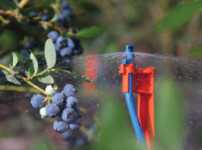Improving Blueberry Irrigation

Ever since he started working with blueberries, David Bryla couldn’t understand why growers said they had always been told they had to water on both sides of the row. After all, it’s not like blueberry plants are enormous, says the research horticulturist. Bryla formerly worked at the USDA facility in Parlier, CA, where he worked mainly in peaches, but he’s now at the USDA Horticultural Crops Research Lab in Corvallis, OR, focusing on berries.
“The drip lines were so close together, it didn’t make sense to me,” he says. “But then I learned that all the information on irrigation water placement was based on pot studies.” The split-root studies done in the 1980s on potted blueberry plants did indeed reveal that applying irrigation — and fertilizer as well — on only one side of the plant reduced growth and production on the other side, suggesting that blueberry plants had little ability to transport water and nutrients laterally. But the work had never been verified in the field, says Bryla.
It’s easy to forget, what with so many acres planted today, that blueberries were very much a minor crop in the not-so-distant past. “No one’s really looked at blueberry roots that much,” he says. “Blueberry is not a well-studied crop.”
In The Field
Seeking to help rectify the situation, Bryla and his team embarked on a field study in 2009 of a mature planting of Elliott variety blueberries. Plants were either irrigated on only one side or fertilized on only one side and compared to plants irrigated and fertilized on both sides. Bryla found that his hunch was correct, as shoot growth, yield, berry size, plant water status, and leaf nitrogen (N) were similar on both sides of the plant whether water and N fertilizer were applied to one or both sides.
“Blueberries can transfer water and nutrients from roots on one side to the shoots on the other,” he said. “However, even though that is true, a grower wouldn’t want to apply water in one spot because spreading water and fertilizer out has a benefit. It’s just not for the reason that was believed, that the plants can’t transfer them.”
Spreading out water and nutrient applications do help because they can maximize the capacity of the plants’ root systems, Bryla explains. That’s critical in a crop that has such a sensitive root system. Blueberries’ extreme sensitivity to soil pH, for example, is well-known, but as many growers know, their shallow roots are also extremely temperature-sensitive. And in part because of that fact, his team’s research has even more implications for growers.
East Is Best
Blueberries are not only shallow-rooted, they produce far more roots on the east side than on the west. Using photographic equipment that has only become available in recent years that has allowed him to see the roots underground, Bryla and his associates found that three times as many roots were produced on the east side of the plants than on the west side. This stunning difference held true regardless of the N treatment.
The reason for this difference lies in the soil temperatures, says Bryla, who adds that three separate studies have come to that conclusion. “More work needs to be done,” he says, “but optimum growth appears to occur from 14°C to 16°C (57°F to 61°F).”
Because of that difference, growers may get more shoot growth if they apply water and nutrients on the east side of plants than on the west. As for root growth, Bryla’s early root imaging results show that for obvious reasons, unfertilized plants tend to produce deeper roots than fertilized plants, and that the unfertilized plants will also produce 2 to 2½ times more roots than fertilized plants.
Fertilizer placement, however, didn’t have any appreciable effect on the plants except on their N status, says Bryla, though he cautioned growers not to make huge changes to their nutrition programs without further study. “Reducing N fertilizer or only applying it to only one side didn’t reduce yield over the short life of the study (three years),” he says, “but in the long run it might well have.”
Implications
Traditionally, growers used sawdust both for weed control and because blueberries like a lot of organic matter. But because sawdust is relatively expensive, growers now commonly use weed mats. But Bryla’s recent study highlights the fact that blueberry roots are so critical to production, and that because they are shallow they must be protected from high temperatures and evaporation. “What impact does the use of weed mat have on production and plant health over the long term?” he asks rhetorically. “More research is needed.









